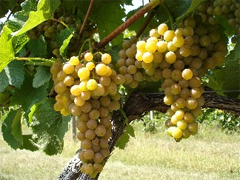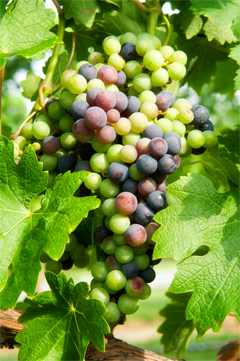Viticulture Extension: Grape Grower Checklist

Welcome to the Virginia Tech's New Grape Grower Checklist. This compilation of information and links for grape growers was created to address inquiries for commercial grape growing and vineyard establishment information in Virginia. The Commonwealth's wine industry continues to expand with more than 300 licensed wineries, and approximately 3,500 acres of vineyard in 2021. Current interest in expansion of vineyard acreage has resulted in an increased demand for research and extension to assist with the growth of new farmland by both experienced and novice grape growers. Below you will find a heading in bold for each of the criterion in the checklist. Each heading is followed by a brief description of our online resources.
The Role of Virginia Cooperative Extension (VCE)
Virginia Tech has served the needs of the wine industry through Virginia Cooperative Extension (VCE) for over 25 years. Specialized training for county extension agents and the recent hiring of two new enologists are major advances. The Viticulture group includes Dr. Tony Wolf, Professor and Viticulture Extension Specialist, Dr. Mizuho Nita, assistant professor and Grape Pathology Extension Specialist and Tremain Hatch, Viticulture Research/Extension Associate. The Enology group includes Dr. Amanda Stewart, Assistant Professor and Dr. Beth Chang, Enology Extension Specialist. Contact with a VCE agent near your location may also be established by visiting the Virginia Tech VCE website below. The information compiled in this checklist represents the most up-to-date information for assisting new grape growers. Reading thoughtfully through the information in this checklist will enhance your knowledge of what is required to locate and establish your vineyard site and make the most of your time allocated with a VCE agent.
- Virginia Cooperative Extension
- Tremain Hatch
- Virginia Grape Disease Updates (Dr. Mizuho Nita's Blog)
Selecting Your Vineyard Site
Site may very well be the most important criterion for a successful commercial vineyard operation. Fortunately there have been many efforts by Virginia Tech to guide your decisions while searching for your vineyard site. Read about site selection in the Wine Grape Production Guide for Eastern North America.
Check out our site suitability tool here: East Coast Viticultural Suitability Investigative Tool
Soil Analysis: When, How, What and Why to Test and Where to Send Soil Samples?
Detailed soil analyses must be made before the vineyard is established, primarily to determine pH but also soil fertility. Reports from soil analyses will not only be essential for understanding the grapevine growth potential in your site, but will also provide key information to your cooperative extension service to assist with soil management recommendations.
When: Soil samples should be collected when the soil is moist and not frozen; fall is an excellent time. Soil test kits are available from some county Cooperative Extension offices.
How: Instructions on how to collect a soil sample may be reviewed in Chapter 8 of "Wine Grape Production Guide for Eastern North America".
What: The most useful soil analyses in a new vineyard site include; soil pH, P, K, Ca, Mg, Zn, Mn, Cu, Fe, B, Cation Exchange Capacity (CEC), and Organic Matter (OM). Many laboratories do not include CEC and OM in a standard soil test, and additional fees may be required for those analyses.
Why: Soil pH, CEC and OM are indicative of the availability of nutrients to the grapevines and the potential vigor of vines to be grown on the site. These features are also important in formulating recommendations for liming, rootstock selection and canopy management. A lab report showing the quantities of the macronutrients P, K, Ca, and Mg and micronutrients Zn, Mn, Cu, Fe, and B will alert you of any nutrient adjustments needed prior to planting. Nitrogen is generally omitted from soil analysis in the establishment phase since most Virginia soils are not deficient in the first year. A combination of petiole analysis and visual observation of your vines is recommended for determining nitrogen needs as your vineyard develops. Additional details regarding soil qualities and mineral nutrition of grapevines may be reviewed in Chapter 8 of "Wine Grape Production Guide for Eastern North America".
Where to Send Soil: State's land-grant universities (such as Virginia Tech) often provide soil testing services.
Grape Variety Selection
The location of your vineyard site and local winery demand will be most influential to the variety of grapes you will choose. It is not uncommon to see many commercial vineyards experimenting with a few acres of a less proven variety in Virginia, however, many years are required to test the performance of new varieties and develop acceptance by the winemaker and consumer. Read more about varieties in the Wine Grape Production Guide for Eastern North America.
Sources of Grapevines
Grapevines and rootstocks are available from a multitude of nurseries in North America. It is important to note that grapevines purchased closer to your site will be no more suitable or adapted to your climate than those purchased in Canada, California or Michigan and, therefore, location of the nursery should not be a limiting factor when purchasing grapevine stock. Here is list from our colleagues in Ohio: Nurseries.
For more information about purchasing "clean" plant material check out the National Clean Plant Network Grapes.
Economics of Vineyard Establishment and Operation
Establishing a successful commercial vineyard requires a substantial capital investment as well as sound management decisions from the initial planning stage through the sale or use of the harvested crop. Cost of labor, land, machinery and materials, as well as expected returns, are considered at the following link.
- Wine Grape Production Guide for Eastern North America - See Chapter 1: "Costs and returns of vineyard establishment and operation"
- The Vineyard Financial Calculator
Getting in Tune with Your Grape and Wine Community
The enthusiasm within the grape and wine community in Virginia has never been greater and the increasing number of local and statewide organizations and discussion groups reflects this change. Dr. Tony Wolf publishes a newsletter, "Viticulture Notes," which is the principal extension newsletter used to keep growers and potential growers informed of upcoming meetings, field days, technical information, seasonal reminders, and availability of new publications. An electronic newsletter is available without cost. To subscribe, send an e-mail message Tremain Hatch thatch@vt.edu. Additional information regarding current research projects and grape pest recommendations is available on Dr. Wolf's website link below. A list of grape and wine associations in Virginia and surrounding states is also provided below for your reference. These links provide detailed information about winery locations, events and local grower groups; however, there is no substitute for getting out and visiting with your local wineries to discover the market demands and wine styles in your area.
Virginia Grape and Wine Associations
Out-of-State Resources





